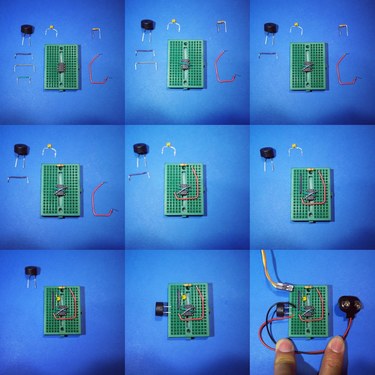## What Does It Do? **The Coqui: a simple device to read a sensor via an audible tone.** We're exploring using audio frequencies to convey sensor readings -- like a modem, but even simpler -- in order to make sensor readings more accessible for people (or to enable data transmission over ubiquitous audio jacks on PCs and smartphones). ## Latest version The [latest and simplest version of the Coqui](/notes/warren/03-01-2019/build-a-sound-generating-coqui-conductivity-sensor) can be seen in the following images. This version differs from [the previous](/notes/ashkaya/09-17-2016/build-a-coqui-a-simple-water-conductivity-sensor) in a few ways: * smaller, cheaper circuitboard (breadboard) * fewer wires * flatter wires which make it easier to see the circuit However, the circuit is fundamentally the same! Click these images to enlarge: [](/i/28988?size=original) [](/i/32338?s=o) ## Assemble the Coqui Here are a few guides to building different versions of the Coqui: [notes:grid:activity:coqui] ## Coqui versions The Coqui has been refined, remixed, and modified plenty over the years. [activities:coqui-version] ## Modify the Coqui [activities:coqui-mods] ## Do something with the Coqui Once you've built a Coqui, here are a few things you can do with it: [notes:grid:activity:coqui-usage] Add an activity or request an activity guide you don't see listed **** ## Frequently Asked Questions [questions:coqui] **** [](https://i.publiclab.org/system/images/photos/000/007/410/original/coquibb.JPG) A Coqui is a simple, inexpensive, open source device that generates an audible tone that is based on any electric resistance-based measurement. For example, a Coqui can measure: * conductivity of liquids * temperature * ambient light ## Build a Coqui Instructions on the breadboard-based "BBv1.0" edition of the Coqui can be found here: http://publiclab.org/notes/donblair/09-30-2014/coqui-bbv1-0 ### Notes - The github repo for a more permanent printed circuit board version of the coqui is [here](https://github.com/OpenWaterProject/coqui) The Coquí is a circuit that allows you to 'hear' the readings from various sensors. Once the Coquí is assembled, you'll be able to 'hear' the conductivity of a solution, the temperature of a room, or the color of a pH test strip. The design was named (onomatopeically) after the several species of small frogs which have a loud, distinctive call at night. ### Demo Coqui applications - [Testing the conductivity of a solution](http://publiclab.org/notes/donblair/09-30-2014/coqui-bbv1-0-testing-conductivity-of-a-solution): - [Reacting to an LED with sound](http://publiclab.org/notes/donblair/09-30-2014/coqui-bbv1-0-reacting-to-an-led-with-sound): - [Assessing ambient light levels](http://publiclab.org/notes/donblair/09-30-2014/coqui-bbv1-0-assessing-ambient-light-with-a-photoresistor): - [Assessing temperature with a thermistor](http://publiclab.org/notes/donblair/09-30-2014/coqui-bbv1-0-using-a-thermistor-as-a-temperature-probe): - [Sending water quality voicemails with a coqui using vojo.com](http://publiclab.org/notes/donblair/09-10-2014/water-quality-coqui-voicemails): [](http://publiclab.org/notes/donblair/09-10-2014/water-quality-coqui-voicemails) ### Building your own Coqui - [Coqui BBv1.0](http://publiclab.org/notes/donblair/09-30-2014/coqui-bbv1-0): a breadboarded version of the Coqui ### Building Coqui sensors - Making a conductivity probe from a [bottle cap and two metal screws](http://publiclab.org/notes/donblair/09-30-2014/making-a-diy-conductivity-probe-from-a-water-bottle-and-metal-screws) ## Parts list See the initial parts list here: #13459 and #11209 for a DigiKey shopping cart link at $19 per kit. And @kanarinka mentions: > there are a couple other things that are helpful to have that are not shown (like the probe made from the top of a water bottle with two screws in it and alligator clips to attach that to the breadboard) Scans of an invoice from DigiKey: [](https://publiclab.org/system/images/photos/000/023/760/original/Screenshot_2018-02-28_at_9.59.17_AM.png) [](https://publiclab.org/system/images/photos/000/023/761/original/Screenshot_2018-02-28_at_9.59.46_AM.png) ...
| Author | Comment | Last activity | Moderation | ||
|---|---|---|---|---|---|
| WhiteRabbit | "Also, FWIW, not all stainless steels are the same. For instance, 316 SS is more resistant to corrosion than 304. " | Read more » | over 10 years ago | |||
| WhiteRabbit | "You'll probably need to correct for differences in sample temperature. i.e. temperature will affect the conductivity of the salt solution. So, to..." | Read more » | over 10 years ago | |||
| DavidMack | "seems like a good approach. maybe specify the type of salt: fine sea salt, table salt (with iodine), kosher salt (no iodine), or Himalayan pink sa..." | Read more » | over 10 years ago | |||
| neilh20 | "Hi Don, looks great procedure, and while not knowing if it actually works - it does give a procedure for establishing a range for a specific set of..." | Read more » | over 10 years ago | |||
| unmanaged | "I would be glad to send some SS welding rods to you free of charge... you have access to the scope and tools I do not... I planted the garden today..." | Read more » | over 10 years ago | |||
| bgamari | "Over the last few days I've been busily reworking some aspects of the measurement. Now we have a much lower excitation voltage (currently 100mV, al..." | Read more » | over 10 years ago | |||
| JSummers | "Hi Don, I agree with Cversek that you need to keep the voltage difference small. you also might want to look at using graphite electrodes. The ki..." | Read more » | over 10 years ago | |||
| donblair | "Cversek -- wow, thank you!!! What a useful collection of info. Your note convinced Ben to add a dual op-amp to buffer the conductivity output, and..." | Read more » | over 10 years ago | |||
| kanarinka | "nice work - it's great to see that the conductivity measurement is coming along like this! " | Read more » | over 10 years ago | |||
| cversek | "What is the max amplitude of the voltages you are applying across the screws? If this gets too high you could be electrolyzing the water, other io..." | Read more » | over 10 years ago | |||
| donblair | "Just noticed -- in that last plot, it looks like the 'falling times' (top curve) start 'slumping', whilie the 'rising times' (bottom curve) seem re..." | Read more » | over 10 years ago |